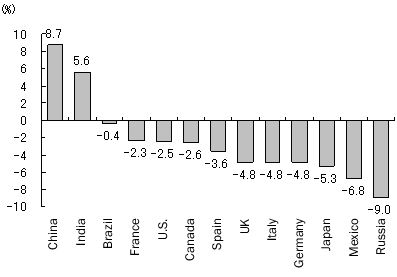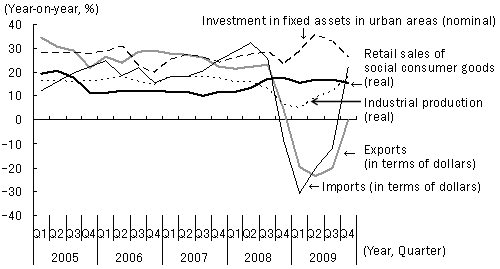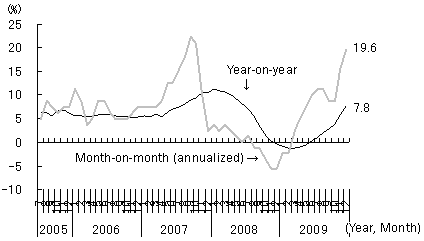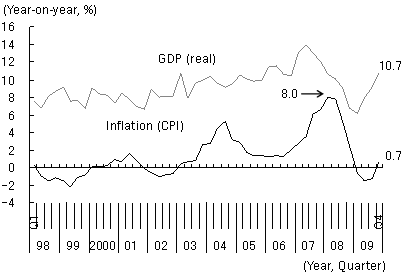Coupled with domestic demand, external demand is also becoming a growth engine
The Chinese economy, which decelerated sharply following the Lehman shock in September 2008, has rebounded ahead of developed countries, thanks to the expansionary fiscal and monetary policies promptly adopted by the government ( figure 1 ). Not only does domestic demand remain firm, exports are also picking up ( figure 2 ). GDP growth reached 8.7% for the full year in 2009, exceeding the 8% growth targeted by the government, and hit 10.7% in the fourth quarter, achieving double-digit growth for the first time since Lehman Brothers went under.
Figure1: Growth Rates of Major Countries in 2009 (Estimates)

(Source) IMF, World Economic Outlook Update , January 26, 2010
Figure2: Major Macroeconomic Indicators in China

(Note) Real retail sales of social consumer goods are derived from nominal figures using CPI as the deflator.
(Source) National Bureau of Statistics of China
In terms of domestic demand, retail sales of social consumer goods (in nominal terms) rose 15.5% year on year for 2009 (16.4% in real terms), as strong automobile sales (up 32.3%) in particular drove overall consumption. Rising income and asset prices as well as improvements in employment should continue to support consumption. Growth in investment in fixed assets nationwide (in nominal terms) was also high at 30.1% year on year for 2009 (30.5% in urban areas), following the adoption of an economic stimulus package worth four trillion yuan centering on public investment, announced in November 2008. Of this growth, investment in railways increased most on a year-on-year basis, climbing 67.5%. It is expected that the major focus of investment will shift with the economic recovery from the government sector to the private sector.
In terms of external demand, although growth in exports and imports contracted to -16.0% and -11.2% year on year, respectively, for 2009, they are now rebounding. Growth in imports has accelerated to 55.9% year on year in December, up from 26.7% in November, while growth in exports has also turned positive, up 17.7% year on year in December, the first positive figure in 14 months. In China, movements in imports are a leading indicator of exports, as intermediate goods such as components and raw materials have to be imported first to boost exports, since the ratio of processing trade to overall trade is high. A sharp increase in imports in recent months suggests that exports will recover strongly in the months ahead. It is likely that growth in exports will continue to turn positive since the yuan, which has been loosely pegged to the U.S. dollar since July 2008, has fallen against other major currencies, and the global economy is beginning to improve.
Ultra-loose monetary policy has been revised
Since September 2008, the Chinese government began drastically easing its monetary policy, accompanied by expansionary fiscal policy to offset the global financial meltdown. It cut interest rates, reduced reserve requirements and eliminated caps on total lending amounts. Following these initiatives, growth in monetary supply (M2) and lending in yuan has been accelerating, and this has in turn driven up asset prices and heightened inflationary pressure.
First, the Shanghai Composite Index, which collapsed to around 1700 points in early November 2008, has climbed sharply since then, and has been above 3000 points since November 2009. Real estate prices, which experienced a temporary correction, have also been rising and taking on the features of a bubble. Housing prices in 70 large and medium cities fell on a month-on-month basis for seven consecutive months starting August 2008, but began to rise again in March 2009. By December, prices were rising 1.5% on a month-on-month basis (19.6% on an annualized basis) ( figure 3 ). On a year-on-year basis, housing prices were up 7.8% in December, compared with a -1.3% contraction in March.
Figure3: Surging Real Estate Prices Taking on the Features of a Bubble - Housing prices in 70 large and medium cities -

(Source) National Bureau of Statistics of China
In addition, the inflation rate (CPI on a year-on-year basis), which had been negative since February 2009, turned positive in November, at 0.6%, and accelerated to 1.9% in December. Given the observation that the inflation rate lags the economic growth rate by about three quarters, it is likely to rise in the months ahead, following the recent sharp economic recovery.
To maintain stable growth, the authorities have begun executing their strategy for exiting the expansionary monetary policy hitherto employed. Limits were already being imposed on certain loans since the summer of 2009, and this has resulted in a contraction in growth in loans on a month-on-month basis. The People's Bank of China (the central bank) also raised reserve requirements applicable to large banks by 0.5 percentage points on January 18, 2010. It is likely that the central bank will opt for further tightening, including a rate hike, as the inflation rate climbs. Past experience shows that the authorities usually implement a rate hike when the inflation rate as measured by the consumer price index exceeds 4%, and given the time lag between GDP growth and inflation, China is likely to reach this stage in mid 2010 ( figure 4 ).
Figure4: GDP Growth Rate and Inflation Rate in China

(Source) National Bureau of Statistics of China
If monetary tightening is delayed, the asset bubble will balloon and inflationary pressure will mount, which will eventually force the authorities to adopt stronger tightening measures. As a result, the banking sector will be burdened with a larger volume of bad debt than it otherwise would have, and the overall economy will be harder hit when the bubble bursts. Although the recent series of moves adopted by the authorities in relation to its monetary policy exit strategy have driven share prices lower, they should in fact be valued as measures to prevent a hard landing.


